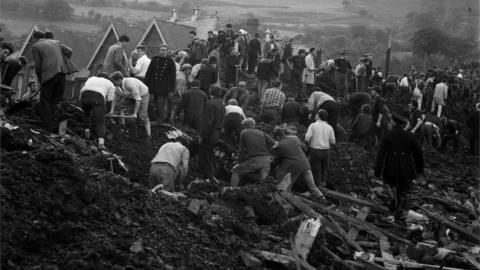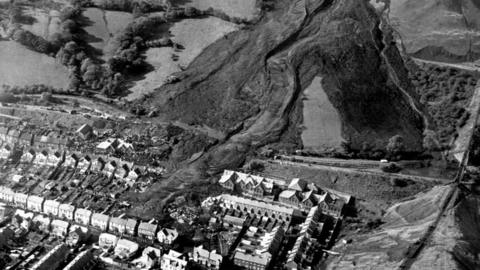On the morning of October 21, 1966, the small Welsh mining village of Aberfan, nestled near Merthyr Tydfil, was a picture of everyday life. Children were settling into their math lessons at Pantglas Junior School, and adults were going about their routines. But in a matter of moments, this peaceful scene was shattered by a catastrophic event that would forever etch Aberfan into the annals of history as a symbol of profound tragedy, negligence, and extraordinary resilience. The Aberfan disaster, a mining accident caused by the catastrophic collapse of a colliery spoil tip, claimed the lives of 144 people, 116 of whom were innocent children.
The Day the Mountain Fell: October 21, 1966
The disaster began not with a bang, but with a terrifying roar. Above the village, on a mountain slope, lay Tip No. 7, a massive heap of coal waste from the Merthyr Vale Colliery. This tip had been created over years, built directly over a natural spring – a critical oversight that proved fatal. Years of rain had saturated the waste, turning the seemingly solid mass into a treacherous slurry. On that fateful Friday, at approximately 9:15 AM, nearly 140,000 cubic yards of black, liquefied coal waste cascaded down the hill.
The sheer volume and speed of the landslide were unimaginable. It destroyed everything it touched, engulfing homes and, most devastatingly, Pantglas Junior School and part of the adjacent senior school. Within minutes, the lives of an entire generation of children were extinguished. The silence that followed the initial roar was quickly replaced by the desperate cries of parents, rescuers, and survivors. The scene was one of unimaginable horror and chaos, a peaceful Welsh village transformed into a burial ground.
A Village Shattered: The Unbearable Human Cost
The human toll of the Aberfan disaster was staggering and heartbreaking. Of the 144 lives lost, 116 were children, most of whom were pupils at Pantglas Junior School. The remaining 28 victims were adults, many of them teachers who had bravely tried to shield their students. This tragedy left an indelible scar on the Aberfan community, as nearly every family lost a loved one, or knew someone who did. The impact was profound, affecting the very fabric of the village.
The disaster not only took lives but also shattered the innocence and faith of many. As one individual, 14 years old at the time, recounted, the disaster sparked deep discussions in schools about why God would allow so many children to die. It was a question that resonated throughout the nation, highlighting the immense emotional and spiritual burden borne by those affected.
The Root Cause: A Disaster Waiting to Happen
The Aberfan disaster was not an unforeseeable act of nature; it was a man-made catastrophe rooted in negligence and a lack of foresight. The coal spoil tip, built by the National Coal Board (NCB), was constructed on a permeable base directly above an active natural spring. Despite warnings from local residents about the tip's instability and the presence of water, these concerns were largely ignored. The official inquiry that followed unequivocally blamed the NCB for the disaster, citing "ignorance, ineptitude and a failure in communications." The report highlighted the dangers of coal mining not just for those underground, but also for communities living in the shadow of its waste.
A Nation Mourns: Royal and Public Response
The news of the Aberfan disaster sent shockwaves across the United Kingdom and around the world. The outpouring of sympathy and support was immense. Queen Elizabeth II, during her 70 years on the throne, witnessed countless tragedies, but Aberfan was one she reportedly never forgot. Her delayed visit to the village, though initially criticized, was followed by a deep and lasting connection, symbolized by her later gift of a memorial organ to the Aberfan Calvinistic Methodist Chapel, which became a Grade II listed building in 1999.
Immediately following the disaster, the Aberfan Disaster Memorial Fund (ADMF) was established on the very day of the tragedy. It received nearly 88,000 contributions from around the world, totaling an astounding £1.75 million. This fund provided crucial financial assistance to the bereaved families and played a vital role in helping to rebuild the shattered community. It was a profound display of global solidarity and community spirit in the face of unimaginable loss.
The Long Road to Justice and Remembrance
The aftermath of Aberfan was not without its struggles. While the ADMF provided support, the fight for justice and safety was prolonged. The remaining spoil tips above Aberfan posed a continued threat, and residents had to wage a lengthy battle against resistance from the NCB and the government, who initially cited cost as a reason not to remove them. Eventually, after immense pressure and public outcry, the tips were removed, a testament to the community's unwavering determination.
In the years following the disaster, Aberfan has continued to remember and honor those who lost their lives. Commemorations, particularly on the anniversaries, serve as poignant reminders of the tragedy and the resilience of the survivors. The Aberfan Disaster Memorial Fund continues its work, ensuring that the legacy of the victims is honored and that the community continues to heal and thrive.
Aberfan's Enduring Legacy: Lessons Learned and Stories Told
The Aberfan disaster remains a powerful and somber reminder of the human cost of industrial negligence. It fundamentally changed attitudes towards industrial safety and environmental responsibility in the UK. While it highlighted the dangers of coal mining, it also showcased a profound display of resilience, community spirit, and the enduring power of remembrance.
The true story of the Aberfan disaster has resonated beyond its immediate impact, finding its way into popular culture. The 1966 Welsh mining tragedy, which claimed the lives of 116 children and 28 adults, features heavily in the third season of Netflix’s “The Crown,” bringing the historical event to a new generation of viewers and ensuring its story continues to be told.
Today, on anniversaries like October 21, the memory of Aberfan remains vivid. It is a day to remember the victims, the majority of whom were children and teachers at Pantglas Junior School, and to hear the accounts of the survivors. It encourages us to reflect on the importance of safety, accountability, and the strength of the human spirit in the face of unimaginable adversity.
In summary, the Aberfan disaster of October 21, 1966, was a catastrophic collapse of a coal waste tip that tragically claimed 144 lives, predominantly children, due to severe negligence by the National Coal Board. This heartbreaking event not only exposed critical flaws in industrial safety but also galvanized a global outpouring of support through the Aberfan Disaster Memorial Fund. The community's arduous fight for justice and the removal of remaining tips, coupled with ongoing remembrance efforts, underscore a powerful narrative of resilience, collective mourning, and an enduring commitment to honoring the victims, ensuring that Aberfan's lessons are never forgotten.



Detail Author:
- Name : Dell Kirlin
- Username : alexandrine.harber
- Email : sherwood.pouros@hotmail.com
- Birthdate : 1986-08-12
- Address : 873 Olson Ford Suite 631 New Bruceville, IN 62018-4368
- Phone : 220.854.8593
- Company : DuBuque-Harber
- Job : Travel Clerk
- Bio : Autem quia minus laudantium nulla. Quo harum voluptatibus corrupti minima explicabo pariatur in. Ut cupiditate odio autem ut.
Socials
linkedin:
- url : https://linkedin.com/in/emmanuel_real
- username : emmanuel_real
- bio : Blanditiis sit repellendus facilis laborum.
- followers : 1384
- following : 2441
twitter:
- url : https://twitter.com/nader2023
- username : nader2023
- bio : Eos odit rerum qui qui est ducimus quaerat unde. Architecto et iste delectus sed in libero voluptas reiciendis. Dolorum quidem nulla libero hic.
- followers : 253
- following : 2149
facebook:
- url : https://facebook.com/nadere
- username : nadere
- bio : Dolor est adipisci porro ducimus voluptas ut. Porro molestiae quo qui a aut.
- followers : 5474
- following : 1810